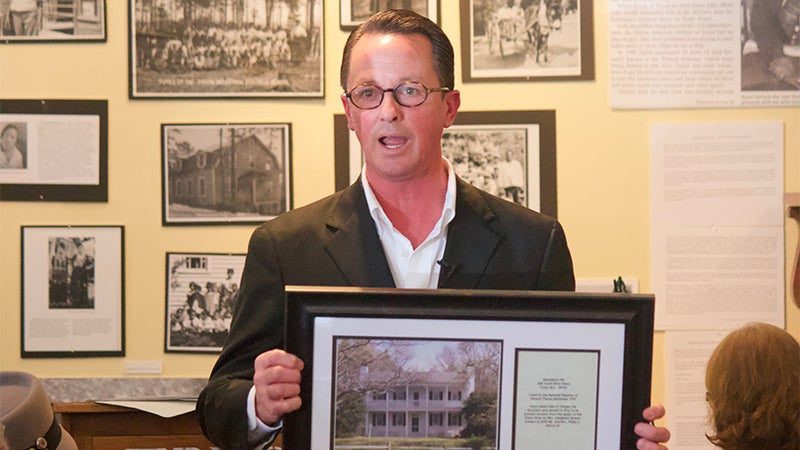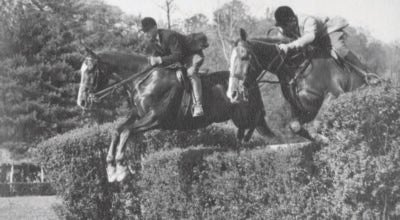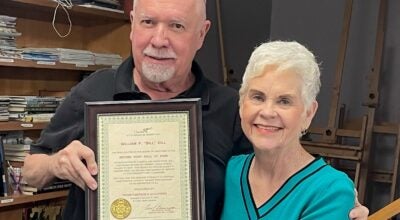Living inside a part of Foothills history
Published 8:00 am Saturday, March 17, 2018

- Local realtor Gary Corn shows off a photo of the town’s historic Blackberry Hill home to the audience packed inside the Tryon Historical Museum Wednesday. Corn — who owns another historic Tryon property, Mill Farm Inn — delivered a presentation about several area homes that are on the National Register of Historic Places during his talk, “Tales of Tryon,” that afternoon. (Photo by Ted Yoakum)
Local realtor discusses Tryon’s oldest homes
TRYON — History can be found pretty much anywhere in a region as steeped in tradition as the Foothills.
From a litany of books chronicling the tales of people who originally settled in the area to the different museums housing artifacts and photos from the early days of Polk County, there are plenty of ways to connect with the events of days gone by.
For a few Tryon residents, however, the rich history of the Foothills can be found within the walls and halls of the place they call home.
On Wednesday, local realtor Gary Corn shared the stories of a few of these homes — including his own — to the standing room only audience at the Tryon Historical Museum during his presentation, “Tales of Tryon.” Corn — who, along with his partner and spouse, James Blanton, owns the historic Mill Farm Inn on Harmon Field Road in Tryon — shared the origins of the seven historic Tryon manors still used as private residences today, and described the process of applying to have one’s property listed on the National Register of Historic Places.
The federal register, established by the passage of the 1966 National Historic Preservation Act, is an official listing of buildings, objects, districts and other properties that are established to have historical significance: be it for architecture, any historical events that occurred there, any significant figures who may have owned or been associated with the property, or if any historical information may be gleaned from it.
The process of having one’s property evaluated and placed on the register is often a complicated — and time-consuming — process, Corn said.
“What do you get for all that time and effort? You get a piece of paper,” he joked.
While states and communities may have their own policies to ensure the strict preservation of historic properties, the U.S. Department of the Interior, which oversees the register, does not monitor owners of historic property — there is no “National Register police,” as some believe, Corn said.
“You are asked to maintain the integrity of the home — and most people do,” Corn said. “But if you want to change every window in your house and gut the walls, you can. There is no protection offered by the legislation. It is a designation.”
Among the 23 properties in Polk County included on the register, there are seven Tryon estates that are still used as private homes to this day: Blackberry Hill, Friendly Hills, Lynncote, Mills-Screven Plantation, Seven Hearths, Stone Hedge and Mill Farm Inn.
Corn and Blanton have owned the inn since 2005, and had the property accepted into the historic register in January 2009.
The two became interested in owning and maintaining a historic home after reading the book “Adventures with Old Houses,” written by Richard Jenrette, whose brother lived in Tryon, Corn said.
Upon first seeing the Mill Farm Inn property, Corn said he could never envision himself living in such an old property — though things quickly changed after getting a tour of the place.
“We [Blanton and I] went on a Sunday — on Wednesday, we had signed the contract to make it our home,” he said. “We have spent all of our time and all of our money — 13 years of our lives — turning it into what it is now.”
The two still maintain the property as a private residence, with a few apartments on the premises. Over the years, they have replaced practically all the furniture they brought with them for the move with period-appropriate furnishings.
“Everything we used to own is gone,” Corn said. “I think there is a chair in the bathroom [we still have]. … It has been like that the whole time. There is always something. You are always trying to improve [the home], and make it what it should be.”





